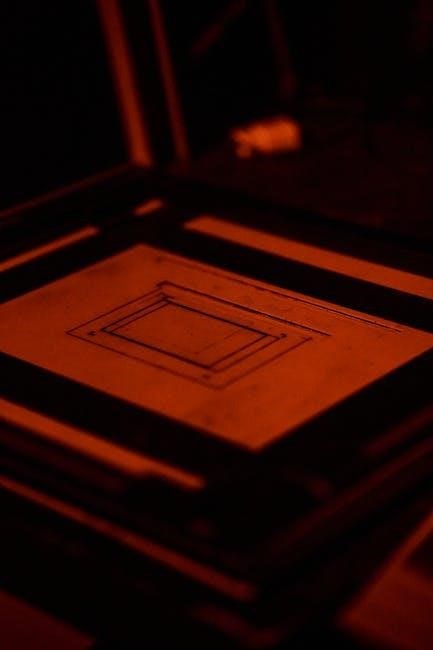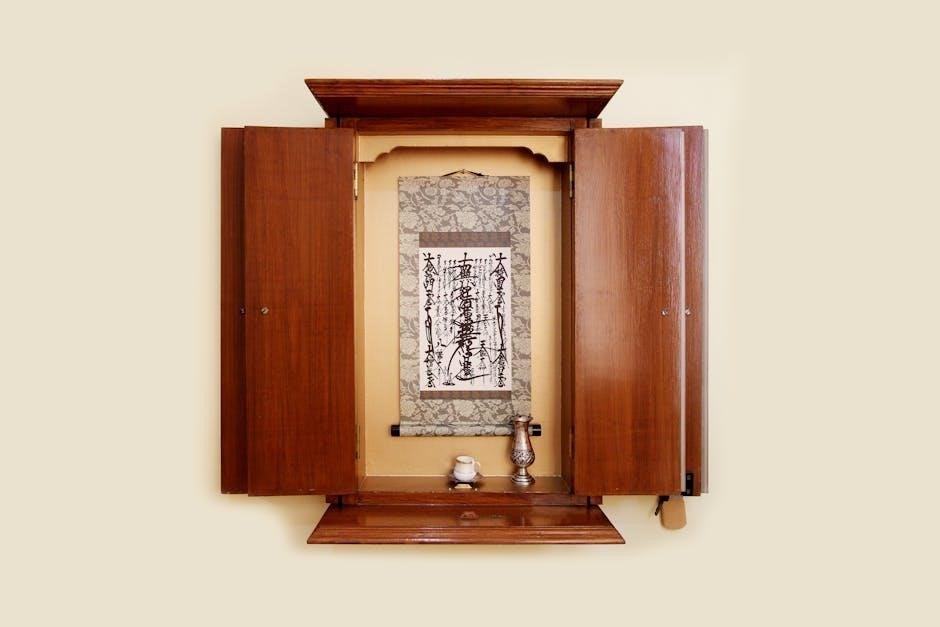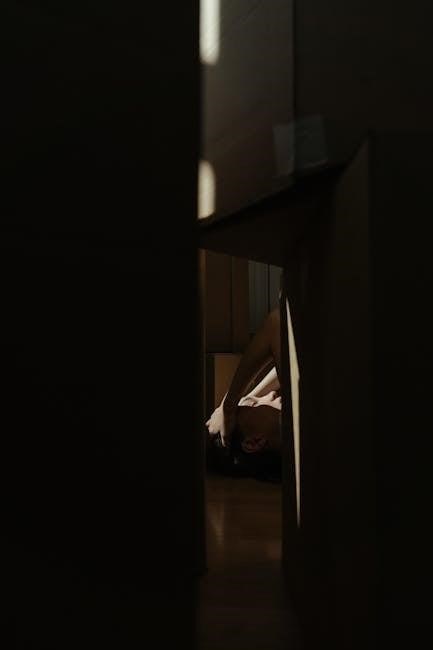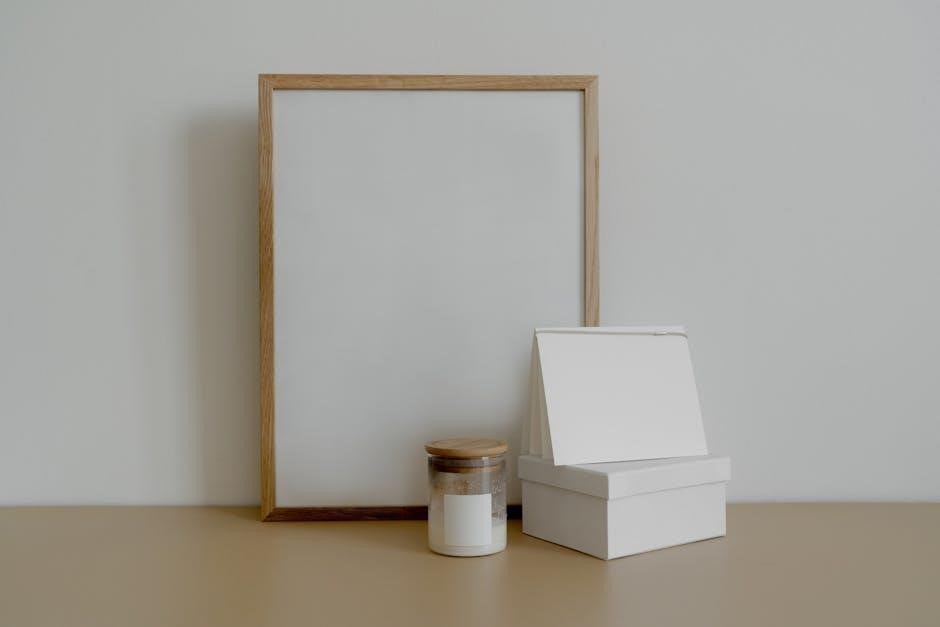A 5-frame nuc box is a compact, essential tool for beekeeping, ideal for managing small colonies, splits, and queen rearing. This guide provides detailed plans and instructions for constructing durable, functional nuc boxes, including material lists, assembly techniques, and design variations. Perfect for beekeepers of all levels, these plans ensure space efficiency and cost-effectiveness, helping you maintain healthy, thriving bee colonies.
What is a 5-Frame Nuc Box?
A 5-frame nuc box, short for nucleus colony box, is a compact beehive designed to house a small colony of bees. It typically holds up to five frames, where bees store honey and brood. Unlike full-sized hives, nuc boxes are smaller, making them ideal for managing splits, swarm control, queen rearing, and monitoring small colonies. Their reduced size allows for easier handling and transportation, while still providing enough space for bees to thrive. Nuc boxes are a versatile tool for beekeepers, enabling them to maintain healthy, productive colonies in a more manageable form. They are especially useful for expanding apiaries or transferring bees to larger hives when the colony grows.
Importance of Nuc Boxes in Beekeeping
Nuc boxes play a critical role in beekeeping by providing a controlled environment for managing small bee colonies. They are essential for splitting hives, controlling swarms, and introducing new queens, ensuring the health and productivity of the apiary. Nuc boxes allow beekeepers to monitor colony strength, resource storage, and pest levels effectively. Their compact size makes them ideal for nurturing young colonies or experimenting with genetics. By using nuc boxes, beekeepers can maintain genetic diversity, prevent overcrowding in full-sized hives, and manage resources efficiently. This tool is vital for sustainable beekeeping practices, enabling beekeepers to support colony growth and resilience while minimizing risks associated with larger hives. Their versatility and practicality make nuc boxes an indispensable asset for both experienced beekeepers and newcomers to the craft.

Why Choose a 5-Frame Nuc Box?
The 5-frame nuc box is a popular choice among beekeepers due to its balanced capacity and versatility. It offers ample space for colony growth while remaining manageable and portable. This size is ideal for nurturing small colonies, making splits, and queen rearing, as it allows bees to maintain a stable cluster size. The 5-frame design minimizes the risk of overcrowding and resource depletion, ensuring the colony’s health and productivity. Additionally, its compact footprint makes it easier to handle and transport compared to larger hives. Many beekeepers prefer this size because it strikes a perfect balance between functionality and practicality, making it suitable for both hobbyists and commercial operations. The availability of detailed PDF plans further simplifies construction, ensuring durability and efficiency for beekeeping success.

Materials and Tools Needed
Constructing a 5-frame nuc box requires 3/4″ thick lumber, 1/2 plywood, and essential tools like saws, drills, and box joint jigs for precise assembly and durability.
Lumber Requirements for Construction
Building a 5-frame nuc box requires high-quality lumber for durability and functionality. The hive body is typically constructed using 3/4″ thick lumber, ensuring strength and insulation. The interior dimensions of the hive body are 18-3/8″ by 7-1/2″ by 9-5/8″, providing ample space for the frames and bees. For the bottom board and inner cover, 3/4″ thick lumber is also recommended, with dimensions of 20″ by 9″. The top cover is made from five pieces, including stiles and rails, joined using box joints for secure assembly. Additionally, 1/2″ thick plywood is often used for constructing multiple nuc boxes efficiently. Proper lumber selection ensures the hive remains durable and weather-resistant, while precise measurements guarantee optimal functionality for bee health and colony management.
Essential Tools for Building a Nuc Box
Constructing a 5-frame nuc box requires a set of essential tools to ensure precision and quality. A circular saw or hand saw is necessary for cutting lumber to the required dimensions. A drill and drill bits are needed for creating holes and driving screws. Measuring tools, such as a tape measure and square, are crucial for ensuring accurate cuts and proper alignment. Sandpaper or a sander is recommended for smoothing out rough edges and surfaces. Clamps are helpful for holding pieces in place during assembly. A hammer is useful for tapping parts together, and a screwdriver or impact driver is essential for securing joints. Additionally, safety equipment like gloves and safety glasses should always be worn when working with power tools. These tools will help you build a sturdy and functional nuc box efficiently.
Recommended Fasteners and Hardware

When constructing a 5-frame nuc box, selecting the right fasteners and hardware is vital for durability and functionality. Use 1-1/4″ or 1-1/2″ galvanized or stainless steel screws for assembling the box, ensuring they are resistant to rust and can withstand outdoor conditions. For the hive stand, consider using 2″ screws to provide additional stability. Nails, such as 1-1/2″ galvanized nails, can be used for securing the frame rests and other components. For the roof, small hinges and latches are essential to allow easy access while keeping the hive secure. Additionally, install a metal or plastic IPM screen at the bottom for varmint control and ventilation. All hardware should be durable and weather-resistant to protect the hive from the elements. Properly securing all parts with these fasteners ensures a safe and stable environment for the bees;

Construction Process
Constructing a 5-frame nuc box involves cutting plywood, assembling hive bodies, and securing components with box joints for durability and functionality, ensuring a sturdy home for your bees.
Step-by-Step Assembly Guide
Begin by cutting the plywood according to the layout diagram, ensuring accurate measurements for all components. Assemble the hive body by attaching the sides, front, and back panels using box joints for strength. Secure the bottom board to the hive body, ensuring proper alignment and drainage. Install the cleats to support the frames. Construct the lid by assembling the stiles and rails, then attach it to the hive body. Sand all surfaces for smoothness and durability. Apply a waterproof finish to protect the wood. Finally, assemble the frames and place them inside the hive body. This step-by-step process ensures a well-constructed nuc box ready for your bees.
Cutting Layout Diagram for 4×8 Plywood
The cutting layout diagram for a 4×8 plywood sheet is designed to maximize material efficiency, yielding enough components for four 5-frame nuc boxes. Begin by dividing the plywood into sections for the hive bodies, bottom boards, and lids. Each hive body requires two side panels, a front, and a back piece. The bottom boards are cut to size, ensuring proper fitment with the hive bodies. Lids are constructed from separate pieces, assembled using box joints. The layout diagram provided in the PDF plans ensures minimal waste and precise cuts. Follow the measurements carefully to achieve accurate results. This organized approach allows you to cut all necessary components efficiently, making the assembly process straightforward and time-effective.
Box Joint Construction Techniques
Box joints are a critical component in constructing durable 5-frame nuc boxes, ensuring a strong and secure connection between the hive components. To create box joints, cut matching notches in the ends of the rails and stiles, ensuring precise alignment. Use a table saw or hand saw for clean cuts, and sand the edges for smooth assembly. The top cover is typically made from five pieces, with stiles and rails joined using box joints. This method provides excellent strength and prevents warping. For added stability, apply wood glue during assembly and clamp the pieces until dry. Box joints are particularly effective for the top cover, which must withstand environmental stress while maintaining a snug fit with the hive body. Properly constructed box joints ensure the nuc box remains durable and functional for years.
Design Variations
Explore various 5-frame nuc box designs, including Langstroth nucleus hives, metric or imperial plans, and optional IPM screen bottom boards for enhanced functionality and customization.
Langstroth Nucleus Hive Design
The Langstroth nucleus hive design is a popular choice for beekeepers, offering a space-efficient solution for managing small colonies. Designed by Rev. L.L. Langstroth, this hive type is well-suited for splits, swarm control, and queen rearing. The 5-frame configuration provides ample space for colony growth while maintaining portability. Constructed using 3/4-inch thick lumber, the hive body measures 18-3/8 by 7-1/2 by 9-5/8 inches, with a bottom board and inner cover sized at 20 by 9 inches. The top cover, made from five pieces, features stiles and rails joined using box joints. This design ensures durability and functionality, with optional features like an IPM screen bottom board for integrated pest management. Its compatibility with standard Langstroth equipment makes it a versatile option for beekeepers.
Metric vs. Imperial Unit Plans
Metric vs. Imperial Unit Plans

Both metric and imperial unit plans are available for 5-frame nuc boxes, catering to beekeepers worldwide. Imperial plans, such as the Five-Frame-Nuc-BoxDownload, provide dimensions in inches, while metric plans, like 10024MDownload and 10025MDownload, use millimeters. These designs ensure compatibility with local materials and tools. The imperial plans often reference 3/4-inch lumber, while metric plans may specify 19mm plywood. Precision is crucial, as nominal dimensions can vary slightly from actual measurements. For example, lumber labeled as 1 inch may differ in real-world use. Beekeepers should choose plans that align with their available materials and measuring tools to avoid construction issues. Having both systems allows for flexibility, making the 5-frame nuc box accessible to beekeepers globally.
IPM Screen Bottom Board Design
The IPM (Integrated Pest Management) screen bottom board is a critical component of 5-frame nuc box plans, designed to promote hive health by improving ventilation and reducing pest issues. This design features a screened bottom that allows debris and mites to exit the hive while keeping the colony secure. The screen is typically made from durable materials like 1/8-inch hardware cloth, ensuring longevity and effectiveness. The bottom board is designed with a slight slope to facilitate mite fall and easy cleaning. Many plans, such as those by D. Coates, include detailed instructions for constructing the IPM screen, ensuring proper fit and functionality. This feature is particularly beneficial for beekeepers focused on natural pest control methods, as it enhances colony health without chemical treatments.

Plans and Blueprints
Downloadable PDF plans for 5-frame nuc boxes are widely available, offering detailed designs and measurements. D. Coates’ plans allow constructing four nuc boxes from one 4×8 plywood sheet, with both metric and imperial unit options included for versatility and precision.
Downloadable PDF Plans for 5-Frame Nuc Boxes
Downloadable PDF plans for 5-frame nuc boxes provide detailed blueprints for construction. These plans, such as D. Coates’ design, outline how to build four nuc boxes from one 4×8 plywood sheet. They include cutting layouts, component dimensions, and assembly instructions. Metric and imperial unit versions are available, ensuring accessibility for beekeepers worldwide. The PDFs cover hive body, bottom board, and cover designs, with precise measurements for box joints and frame spacing. Resources like BeeSource.com offer free downloads, making it easy to start your project. These plans are ideal for DIY enthusiasts, providing a cost-effective and efficient way to create durable nuc boxes tailored to your beekeeping needs. Ensure hive functionality and longevity by following the detailed instructions provided in these comprehensive guides.
Coates 5-Frame Nuc Box Design
D. Coates’ 5-frame nuc box design is a popular choice among beekeepers, offering a practical and efficient solution for constructing nucleus colonies. The plan allows you to build four nuc boxes from a single 4×8 sheet of 1/2 plywood, making it cost-effective and space-efficient. The design includes a detailed cutting layout diagram, ensuring precise measurements for all components. Front and rear panels are 9 x 10-3/8 inches, with rabbet joints for added durability. This design is ideal for beekeepers needing scalable solutions, as it supports colony growth and easy transfers to full-sized hives. Coates’ plans are widely available in PDF format, providing clear instructions for assembly and customization. His design emphasizes functionality, making it a favorite for both small-scale and commercial beekeeping operations.
Imperial and Metric Unit Blueprints
Both imperial and metric unit blueprints are available for 5-frame nuc box construction, ensuring accessibility for beekeepers worldwide. Imperial plans include detailed dimensions in inches, while metric plans provide measurements in millimeters. These blueprints cater to different preferences and regional standards, offering precise instructions for building durable nuc boxes. The imperial plans often reference 3/4-inch lumber, while metric plans may specify 19mm plywood for construction. Cutting layout diagrams are included in both versions, simplifying the process of creating components from a single sheet of plywood. Downloadable PDFs for both unit systems are widely available, making it easy for beekeepers to follow instructions tailored to their measuring tools. This dual-option approach ensures accuracy and convenience, accommodating beekeepers across the globe.

Safety and Best Practices
Always wear protective gear, including gloves and goggles, when working with power tools. Ensure hive durability by using proper construction techniques and materials. Avoid common mistakes to maintain functionality and bee health, ensuring successful beekeeping operations.
Working with Power Tools Safely
Safety is paramount when using power tools for constructing a 5-frame nuc box. Always wear protective gear, including safety glasses and gloves, to prevent injuries. Ensure tools are well-maintained and follow manufacturer guidelines. Keep loose clothing tied back and avoid distractions while operating equipment. Use proper lifting techniques to prevent strain. Maintain a clean workspace to minimize accidents. Never operate power tools near children or pets. Always unplug tools when not in use or during blade changes. Proper ventilation is essential when working with materials that produce dust or fumes. Adhere to safety protocols to ensure a secure and efficient building process for your nuc box, protecting both yourself and your workshop environment.
Ensuring Hive Durability and Functionality
To ensure your 5-frame nuc box is both durable and functional, use high-quality materials and precise construction techniques. Opt for 3/4″ thick lumber, as it provides structural integrity and withstands environmental stresses. Properly align and secure all components, such as the hive body, bottom board, and lid, using box joints or other reliable methods. Apply a weather-resistant finish to protect the wood from moisture and pests. Ensure frames are evenly spaced and the hive interior is smooth to promote healthy bee activity. Regularly inspect and maintain the hive to address any wear or damage promptly. A well-built nuc box will support colony growth, simplify management, and ensure long-term reliability for your beekeeping efforts.
Common Mistakes to Avoid
When building a 5-frame nuc box, avoid common errors that can compromise hive functionality and durability. Incorrect measurements are a frequent issue; always adhere to specified dimensions and double-check cuts. Improper use of fasteners, such as over-tightening screws, can damage the wood and create weaknesses. Neglecting to apply a weatherproof finish exposes the hive to moisture damage. Additionally, misaligning components like the bottom board or lid can hinder bee movement and hive efficiency. Ensure proper frame spacing and smooth interior surfaces to promote healthy colony growth. Regularly inspect your nuc box for wear and address issues promptly to prevent long-term damage. Avoiding these mistakes ensures a sturdy, functional hive that supports thriving bee colonies and simplifies beekeeping management.

Building a 5-frame nuc box is a rewarding project for beekeepers. For detailed plans, visit BeeSource or download Coates’ design at Bushkill Farms.
Final Tips for Successful Nuc Box Construction
For a successful 5-frame nuc box build, prioritize precision in cutting and assembling components. Use high-quality, durable materials to ensure longevity. Always follow the plans carefully, double-checking measurements before cutting. Consider adding an IPM screen bottom board for improved pest management. Ensure box joints are secure for strength and stability. Apply a water-resistant finish to protect the wood. For beginners, start with a single nuc box to gain experience before scaling up. Store completed boxes in a dry, protected area until use. Lastly, consult online forums or experienced beekeepers for troubleshooting and additional insights. With careful planning and execution, your nuc boxes will serve as reliable habitats for thriving bee colonies.
Recommended Websites for Nuc Box Plans
For reliable 5-frame nuc box plans, visit BeeSource, which offers detailed PDF guides and construction tips. Bushkill Farms provides Coates-designed plans, ideal for building multiple nucs from a single plywood sheet. Additionally, Yankee Beekeepers Association shares comprehensive blueprints and assembly instructions. These websites are trusted resources for beekeepers, ensuring accurate and practical plans for successful nuc box construction. They also offer additional resources, such as community forums and tips for beekeeping success.
Community Forums for Beekeeping Support

Engaging with online forums is a great way to connect with experienced beekeepers and gain insights into building and using 5-frame nuc boxes. Websites like BeeSource Forums and Yankee Beekeepers Association Forum offer valuable discussions on nuc box construction, troubleshooting, and best practices. These platforms allow you to ask questions, share tips, and learn from others who have successfully built their own nuc boxes. Additionally, forums often feature threads dedicated to specific designs, such as the Coates 5-frame nuc box, providing firsthand experiences and advice. Participating in these communities can significantly enhance your beekeeping skills and ensure the success of your nuc box projects. They are invaluable resources for both beginners and seasoned beekeepers alike.